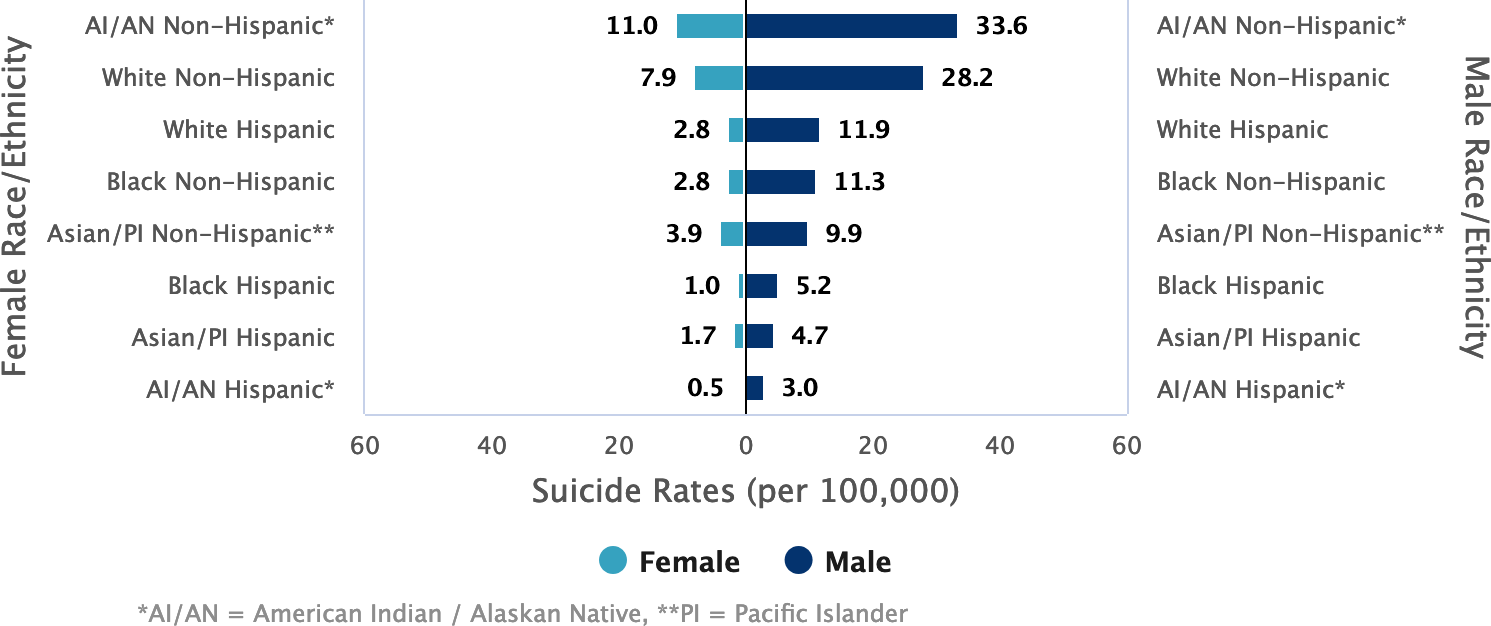In the United States, suicide rates are highest among American Indian, Alaska Native, and white populations. But these broad demographic groups are diverse with regard to national origin and ethnicity, which can mask the impact of suicide in different subgroups. For example, the broad Asian population’s overall low suicide rate may hide the high impact of suicide in some Asian ethnic groups.
American Indians and Alaska Natives
American Indians and Alaska Natives face severe historical trauma, high rates of poverty and isolation, cultural taboos around death and suicide, and lack of access to mental healthcare. Among American Indian and Alaska Native youth, the suicide rate is 3 to 4 times higher than for other American youth and is the second leading cause of death in this age group (WSDOH, 2016).
The risk for co-occurrence of substance abuse, depression, and diabetes is over 12 times higher for AI/ANs than for whites (Cwik et al., 2016). The suicide rate for American Indian juveniles is more than double the white non-Hispanic rate and more than triple the rates for the other racial/ethnic groups (CSAT, 2015).
Hispanic/Latinos
Hispanics/Latinos have fairly similar rates of suicidal thoughts and behaviors compared with white, non-Hispanic individuals. Among youth and young adults, the prevalence of suicidal thoughts and behavior increases among Hispanics/Latinos who are more acculturated to mainstream American culture, particularly among females (CSAT, 2015).
African Americans
The suicide rate for African Americans is 70% lower than that of the non-Hispanic white population. However, the suicide death rate for African Americans men is significantly higher than for African American women (OMH, 2017).
Among African American youth, suicide risk peaks in early twenties for males and late twenties for females. A study looking at suicide rates from 1983 to 2012 for African Americans showed the following: the risk in males increased with age, peaking at ages 20 to 24 years, and then declined except for slight increases at older ages (60–74 years). For females, the risk increased with age until peaking at ages 25 to 29 years and then declined except for slight increases at middle ages (35–44 years) (Wang et al., 2016).
Asian Americans
The six largest Asian American subgroups in the United States are Asian Indians, Chinese, Filipinos, Japanese, Koreans, and Vietnamese; these subgroups account for 84% of all Asian Americans in the United States.*
Among these Asian subgroups, Korean males have more than twice the frequency of death due to suicide (5%) compared to non-Hispanic Whites (2%), and suicide was ranked as the fifth leading cause of death, higher than every other Asian subgroup and non-Hispanic whites. Mortality rates for suicide among Korean males were twice that of any other Asian subgroup (Hastings et al., 2015).
*Additional Asian subgroups residing in the United States include Afghanis, Bangladeshis, Bhutanese, Burmese, Cambodians, Hmong, Nepalese, Pakistanis, Singaporeans, Sri Lankans, Taiwanese, and Thai.
White Americans
Very little research has focused on why suicide rates are high among white populations. CDC data from 16 states show the most common circumstances around suicide for white men include mental and physical health problems, trouble in intimate relationships, alcohol dependence, and problems at work. Cultural taboos about seeking help and appearing vulnerable often isolate white men from both support systems and resources that could help (WSDOH, 2016).
Suicide Rates by Race (per 100,000)

Source: NIMH, 2019 Figure 3. Data courtesy of CDC.
